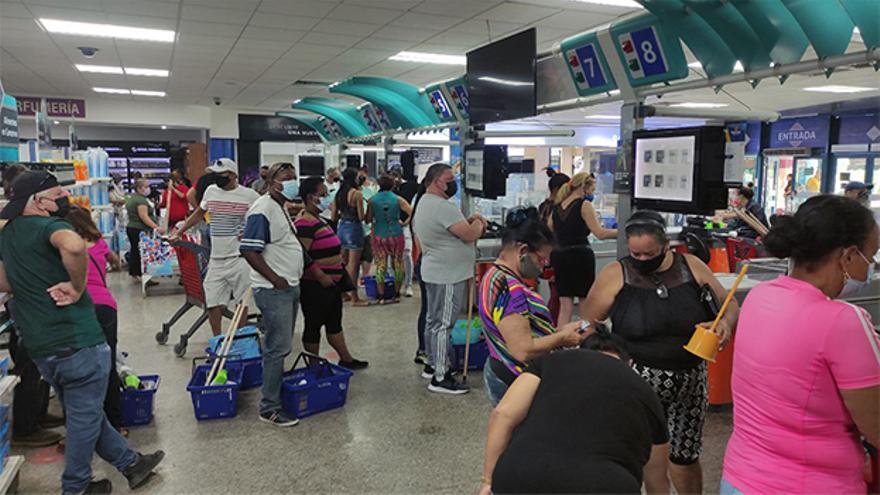
![]() 14ymedio/EFE, Havana, 15 May 2022 — The Cuban government announced this Saturday that it will establish a special exchange rate for some state and private producers of high-demand goods. Without further details, the Minister of Economy, Alejandro Gil, explained that these sectors, “in a selective and gradual manner,” will be able to obtain foreign currency at a price between the official rate of 24 pesos to the dollar and that of the informal market, which reaches 125 pesos.
14ymedio/EFE, Havana, 15 May 2022 — The Cuban government announced this Saturday that it will establish a special exchange rate for some state and private producers of high-demand goods. Without further details, the Minister of Economy, Alejandro Gil, explained that these sectors, “in a selective and gradual manner,” will be able to obtain foreign currency at a price between the official rate of 24 pesos to the dollar and that of the informal market, which reaches 125 pesos.
This move comes two years after the first freely convertible currency (MLC) stores selling groceries and other staples were opened.
According to the minister, a scheme for the sale of foreign currency will be implemented in a “gradual and selective” manner and the Government will agree with suppliers on the prices of commercialization in Cuban pesos, Radio Rebelde published.
Gil explained that this new process will be focused on the production of food and high-demand products. “Today we have a missing piece in the design of the country’s monetary functioning, which is the sale of MLC, that is, of foreign currency, to the population that has a demand for it.”
Regarding the price of the currency, the minister pointed out that it is impossible to maintain a stable offer at the official exchange rate, since this “would require an amount of these currencies that would force us to give up the support of the main needs of the population,” adds the media official.
Also, according to the minister, after this step it is possible to “think about re-establishing the sale of foreign currency to the population.”
The announcement was made during Gil’s presentation in the National Assembly that is in session this weekend and immediately provoked strong criticism.
The economist Pedro Monreal harshly evaluated the official decision: “From the initial dream in 2020 of adopting a single exchange rate, it has gone to three rates: the official one (1:24), the informal one (1≈ 115) and the “secondary”(not yet quantified). One more nail in the coffin of the ’ordering [task]*’ and a possible source of illegalities,” he wrote.
In February of this year, the Cuban economy minister explained that the stores in MLC are a lifeline. “You sell in MLC or you don’t have (currency), because debt is paid or commercial credit is only guaranteed with currency,” he said at the time and defended the opening of stores that take payment exclusively in foreign currency.
The stores in MLC began to operate in Cuba at the end of 2019, first with offers of electrical appliances, hardware or furniture to capture the “dollars that escaped the country,” according to explanations given by the minister at the beginning of 2022. In the summer In 2020, the first markets for food and toiletries appeared, also in foreign currency.
The opening of these stores has been surrounded by strong popular criticism. Cubans complain that the commercial network in Cuban pesos has hardly any products on offer, while in the markets in MLC merchandise is supplied with more regularity and diversity.
During the popular protests last July, foreign currency stores were stoned and looted in several locations in the country. Product resellers have also generated a thriving business of buying in MLC and then offering these goods in national currency at sky-high prices on the informal market.
In his speech at the National Assembly this Saturday, the minister also indicated that the country’s imports between January and April of this year totaled four times its exports.
Exports of goods were about 590 million dollars in those four months, while imports reached about 2.397 billion dollars.
The island’s trade deficit, therefore, stood at 1.807 billion dollars, slightly more than three times the total volume of exports in that period.
*Translator’s note: Tarea ordenamiento = the [so-called] ‘Ordering Task’ which is a collection of measures that includes eliminating the Cuban Convertible Peso (CUC), leaving the Cuban peso as the only national currency, raising prices, raising salaries (but not as much as prices), opening stores that take payment only in hard currency which must be in the form of specially issued pre-paid debit cards, and others.
____________
COLLABORATE WITH OUR WORK: The 14ymedio team is committed to practicing serious journalism that reflects Cuba’s reality in all its depth. Thank you for joining us on this long journey. We invite you to continue supporting us by becoming a member of 14ymedio now. Together we can continue transforming journalism in Cuba.
